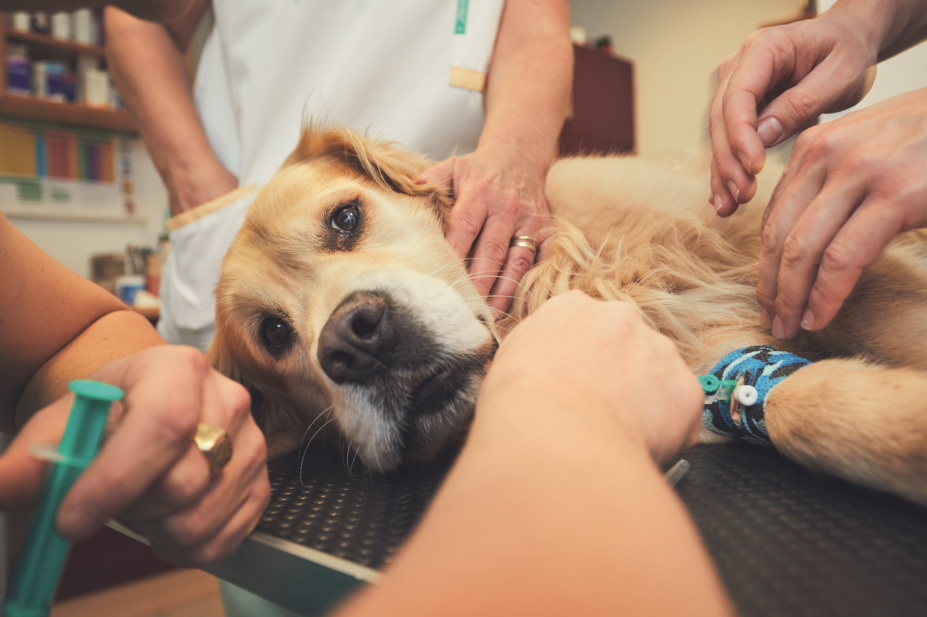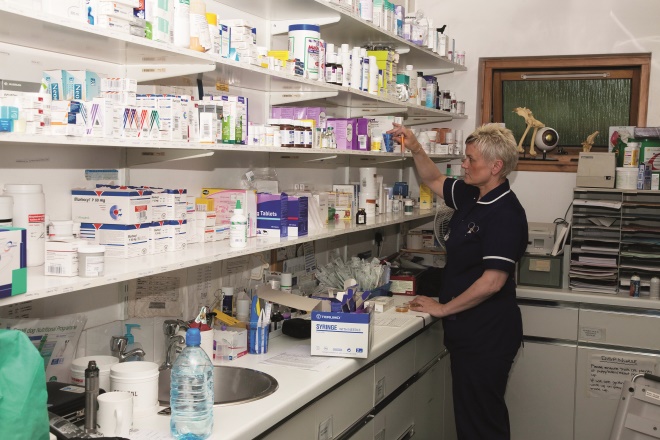
Shutterstock.com
Traditionally, veterinary pharmacy has been concerned with supplying medicines in agricultural and farming areas. But with an estimated 51 million pets in the UK, many community pharmacies now also stock veterinary products — such as parasiticides — to help look after the health of our companion animals.
So how did veterinary pharmacy became a specialty? Steven Kayne is director of the multidisciplinary Veterinary Pharmacy Education Programme, jointly provided by the Royal Pharmaceutical Society (RPS) and Harper Adams University College, and recently set up the independent Veterinary Pharmacy Association (VPA) to promote and support the practice of Veterinary Pharmacy by all veterinary healthcare providers.
Back in the 1950s, pharmacy was at the forefront of animal health, with vets issuing prescriptions and pharmacists dispensing them
He says: “Back in the 1950s, pharmacy was at the forefront of animal health, with vets issuing prescriptions and pharmacists dispensing them, but ongoing responsibilities to the NHS eventually pushed this work back to vets. However, a 2003 Competition Commission inquiry into vets prescribing and supplying medicines led to government policy to better include pharmacy, and since then pharmacists have become more involved, with many now offering [over-the-counter] animal health products and advice, and some 75% of community pharmacies keeping vet products of one description or another.”
Rules and regulations
While it is only veterinary surgeons who can diagnose clinical conditions in animals, pharmacists can prescribe or supply veterinary medicines because of their registration with the General Pharmaceutical Council (GPhC).
However, the government’s Veterinary Medicines Directorate has specific requirements for the prescribing and supplying of veterinary medicines by pharmacists. Its Veterinary Medicines Regulations state that pharmacists can:
- Dispense medicines only prescribed by a veterinary surgeon (known as POM-V) and medicines prescribed by a veterinary surgeon, pharmacist or suitably qualified person (known as POM-VPS), in accordance with prescriptions written by a UK-registered veterinary surgeon, pharmacist or suitably qualified person (SQP);
- Dispense veterinary medicines prepared extemporaneously, but only against a prescription from a veterinary surgeon;
- Dispense human medicines for use under the cascade in accordance with prescriptions written by a veterinary surgeon;
- Prescribe and supply POM-VPS veterinary medicines;
- Supply ‘non-food producing animal — veterinarian, pharmacist, SQP’ (NFA-VPS) medicines, ‘Small Animal Exemption Scheme’ (SAES) products, and ‘authorised veterinary medicines — general sales list’ (AVM-GSL) medicine.
The pharmacist has specific responsibilities when supplying a veterinary medicine other than AVM-GSL, in order to ensure that it is used appropriately. They must be present when it is handed over, unless they authorise each transaction individually beforehand and are satisfied that the person handing it over is competent to do so. This differs from the supply of pharmacy and prescription-only medicines to a human patient, which requires the pharmacist to be physically present at the premises when these medicines are handed over. The regulations also allow pharmacists to break open packages for the purposes of supply, except the immediate packaging of an injectable product.

Source: VeterinaryImages / Alamy Stock Photo
There are opportunities available for all pharmacy professionals, including pharmacy technicians another pharmacy support staff to work in veterinary pharmacy
Pharmacy technicians and other pharmacy support staff who want to play a more involved role in animal health can qualify as an SQP — professionally qualified and regulated animal medicines advisors registered with the Animal Medicines Training Regulatory Authority (AMTRA) or VetSkill. SQPs can prescribe and supply POM-VPS veterinary medicines, and supply NFA-VPS, AVM-GSL veterinary medicines and SAES products.
Further training
Although no specific extra qualification is required for pharmacists to work in veterinary pharmacy, there is a requirement to complete and submit continuing professional development (CPD) records to GPhC, as in community pharmacy. Kayne says that, just as in human pharmacy, if you are going to focus on a specialism you are obliged to be competent: “By virtue of being registered with the GPhC, pharmacists can provide vet pharmacy services without further training, but the majority would struggle to answer queries without further training — so in practice it’s a must, really.”
Veterinary pharmacy courses, such as those offered by Harper Adams University (an accredited training provider for the RPS), are run in conjunction with the veterinary pharmacy education programme and incorporate the AMTRA SQP qualification.
More than half of pharmacy clients have a pet, yet many animals won’t see a vet in their whole lifetime, and it is here that pharmacists can be proactive
Its full postgraduate programme is typically delivered on a part-time basis in a blended learning format and studied over two academic years. Students completing all taught modules gain a postgraduate diploma and those continuing to Master’s level complete thir dissertation over a one- to two-year period. Pharmacy technicians and support staff can study the taught modules on the university diploma, which also incorporates appropriate SQP qualifications.
Health outcomes
And it is not just safeguarding animal welfare that makes the role of veterinary pharmacy important. “Healthy pets equal healthy owners,” says Kayne, “so there is a public health consideration here too. For example, if you go to your GP with a rash on your arm from flea bites they can give you something to treat it, and a vet will treat your animal, but pharmacists can make the crossover between the two — treating both the animal and the human.”
Kayne adds that it is estimated that “more than half of pharmacy clients have a pet, yet many animals won’t see a vet in their whole lifetime, and it is here that pharmacists can be proactive.”
Pharmacist Andrea Tarr founded the Veterinary Prescriber website in 2012, offering impartial, evidence-based information and CPD to veterinary practitioners. She says cutting through the confusion that many pet owners have around disease prevention in their animals, particularly parasite control, is part of a vital service that community pharmacies can provide.

Source: Courtesy of Andrea Tarr
Andrea Tarr is the independent veterinary medicines information site, Veterinary Prescriber
“The animal medicines that can be sold without a prescription in a pharmacy are mainly parasiticides for cats and dogs,” says Tarr, “but this is a confusing area for many people because of the large number of products (including many branded generics) on the market. There is also a poor understanding among pet owners about what protection is needed and which products to choose. Parasite protection needs to be tailored to the individual pet and there are clear clinical guidelines on this, which is where knowledgeable pharmacy staff can advise pet owners on the safe and effective use of the correct choice of product.”
Crossing boundaries
Unsurprisingly, as with any sector crossover, there can be some push-back from vets and others in the multidisciplinary team.
According to Kayne: “The whole concept of a team effort in healthcare doesn’t work all that well in the vet world, and there are still some prejudices”. And Tarr says it seems “vets can see pharmacists as competition and worry about losing their right to prescribe and supply — which has been mooted at European level.”
Nonetheless, pharmacists do have a voice on some veterinary sector bodies. For example, Tarr is the pharmacist representative on The Veterinary Pharmacy Committee (VPC), a multidisciplinary committee with 21 members — one of which is always a pharmacist. Part of the Veterinary Medicines Directorate, the VPC meets about three times a year and advises the Department for Environment, Food and Rural Affairs on vet medicines.
Veterinary pharmacy can be so much more than supplying flea treatments
And Kayne says: “The more contact pharmacists have with colleagues, the better. Don’t be afraid of contacting your local vet and having a chat with them, like we had to do with GPs to get in the loop.”
Professional support
For pharmacists wanting to really immerse themselves in the field, there are lots of sources of information and support. As well as Kayne’s VPA, the RPS has a Veterinary Pharmacy Network forum for all pharmacists interested or involved in the supply of veterinary medicines to discuss and review any non-confidential topics related to veterinary pharmacy, and the RPS Medicines Ethics and Practice is also a useful resource.
When it comes to CPD, manufacturers create reams of materials; the VPA has CPD output in June and in September, and there is ongoing CPD available from Harper Adams. Tarr has also launched a CPD resource on over-the-counter veterinary medicines for pharmacies and SQPs on the Veterinary Prescriber website.
Opportunities for growth
For Kayne and Tarr, the range of opportunities that veterinary pharmacy opens up are what makes it so appealing as a career choice — or add-on.
“Veterinary pharmacy can be so much more than supplying flea treatments,” says Kayne. “If you want to make it your specialty it can lead you into working in veterinary hospital pharmacy, in large vet practices, regulatory affairs or academia.”
“There are also potential roles in the veterinary pharmaceutical industry, and in special formulations manufacturing,” adds Tarr, “although the most accessible opportunity is to develop a veterinary medicines service in community pharmacy. There is a great potential for pharmacies here — it’s the ideal place for pet owners to access impartial advice on pet healthcare and product choice in an environment where there is specialist knowledge about medicines.”
All of which is yet another example of how community pharmacy can provide a wider range of services that give value for money for customers at the same time as offering an innovative and accessible way to meet patient demand — both human and animal — and improve public health.
- This article was amended on 12 September 2018 to clarify that there are an estimated 51 million pets in the UK, not 51 million UK households owning a pet as originally stated.
You may also be interested in
The importance of diverse clinical imagery within health education

Government should consider ways to prevent ‘inappropriate overseas prescribing’ of hormone drugs, review recommends
